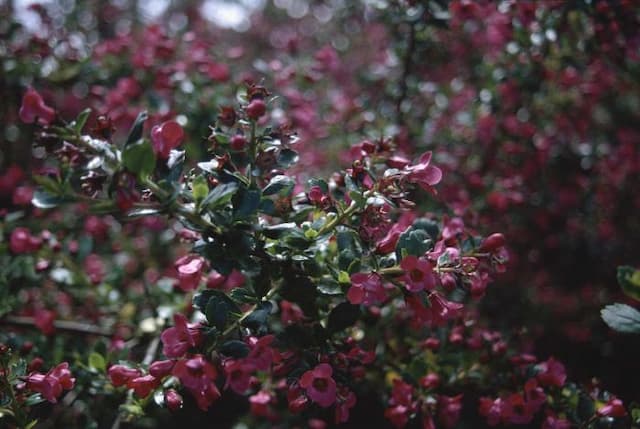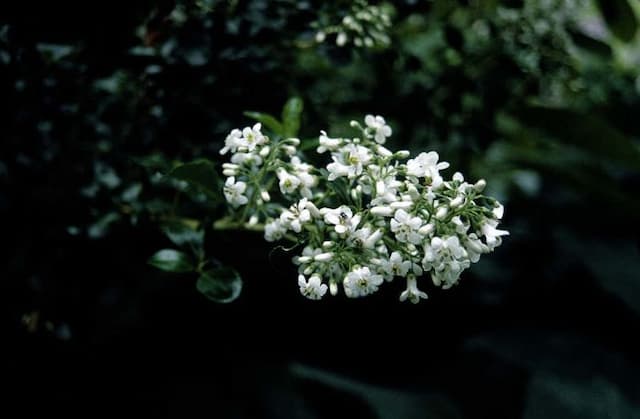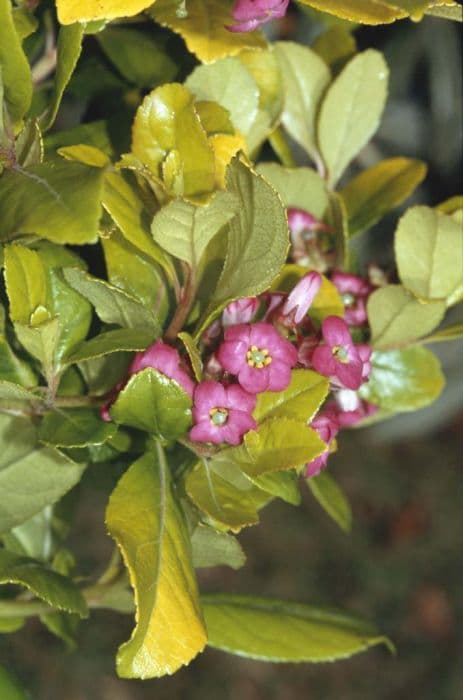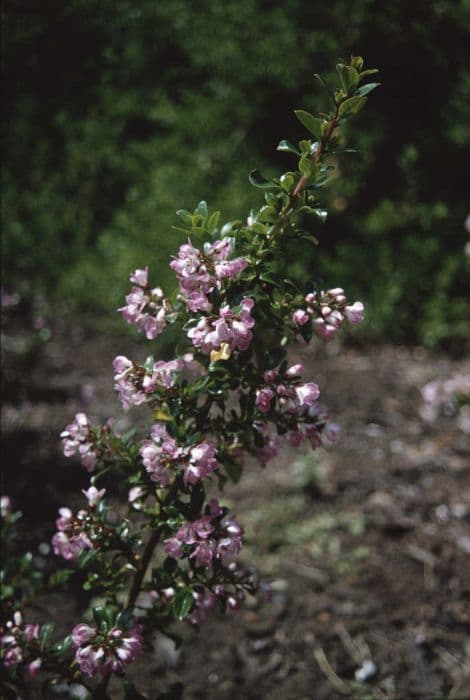Golden Carpet Escallonia Escallonia Golden Carpet = 'Alcaura' (PBR)
![escallonia [Golden Carpet]](/_next/image?url=https%3A%2F%2Fplants-admin.emdemapps.com%2Fimages%2Fplants%2F%2Fimages%2F604b59284be41.png&w=3840&q=75)
ABOUT
Escallonia Golden Carpet 'Alcaura' is a striking garden shrub notable for its vibrant foliage and dazzling floral display. This cultivar is particularly known for its leaves, which exhibit a golden-yellow hue that can add a splash of brightness to any landscaping. These leaves are small and glossy, offering a year-round color that may deepen to a more orange tone in colder weather, providing a warm contrast against gloomier skies. Complementing its golden leaves, this escallonia boasts a profusion of small pink flowers that emerge in clusters. These blossoms appear during early to mid-summer, attracting pollinators such as bees and butterflies to the garden with their delicate form and subtle fragrance. The contrast between the golden foliage and the pink flowers creates a striking visual impact that can enliven garden borders or serve as an eye-catching standalone feature. Escallonia Golden Carpet 'Alcaura' carries a bushy and low-growing habit, forming a dense mat-like shape that is both neat and sprawling. Its branches are slender and may arch slightly, giving this plant a graceful and lush appearance. Maintaining a compact and mounded form, this ornamental shrub is well-suited to a variety of garden styles, where it can be used as ground cover, a low hedge, or an accent plant. Its vivid color and ease of care make it a popular choice for gardeners looking to introduce year-round interest and color into their outdoor spaces.
About this plant
 Names
NamesSynonyms
Golden Carpet Escallonia, Alcaura Escallonia, Golden Carpet.
Common names
Escallonia Golden Carpet = 'Alcaura' (PBR).
 Toxicity
ToxicityTo humans
The Escallonia 'Golden Carpet' is not commonly known to be toxic to humans. However, like many plants, it could potentially cause mild digestive discomfort if ingested in large quantities. It's always best to exercise caution and avoid eating any plant parts unless they are known to be edible.
To pets
Escallonia 'Golden Carpet' is not commonly known to be toxic to pets. However, as with any plant, there is always a risk of gastrointestinal upset if your pet consumes part of it. Watch for symptoms such as vomiting or diarrhea and contact your veterinarian if you are concerned about your pet's health after ingesting this plant.
 Characteristics
CharacteristicsLife cycle
Perennials
Foliage type
Evergreen
Color of leaves
Golden
Flower color
Pink
Height
2 feet (0.6 meters)
Spread
3 feet (0.9 meters)
Plant type
Shrub
Hardiness zones
7
Native area
South America
Benefits
 General Benefits
General Benefits- Attracts Wildlife: Provides a habitat and food source for beneficial insects, bees, and butterflies.
- Year-Round Interest: Offers evergreen foliage for garden interest even during the colder months.
- Easy to Maintain: Requires minimal pruning and is generally low maintenance.
- Drought Tolerant: Once established, it has the ability to withstand periods of low water availability.
- Versatile Use: Suitable for planting in a variety of garden settings such as borders, banks, and beds.
- Compact Growth: Its small size makes it a suitable choice for smaller gardens or limited spaces.
- Ornamental Appeal: Produces attractive, glossy golden-yellow foliage and pink flowers for visual interest.
- Hardy Plant: Resistant to many common pests and diseases, contributing to its longevity and ease of care.
 Medical Properties
Medical PropertiesThis plant is not used for medical purposes.
 Air-purifying Qualities
Air-purifying QualitiesThis plant is not specifically known for air purifying qualities.
 Other Uses
Other Uses- Escallonia can be used as a natural dye source for fabrics, providing a range of colors from the leaves and flowers after proper processing.
- The dense foliage of the Escallonia can create an effective sound barrier in noisy areas when planted in thick hedges or shrub borders.
- Escallonia is ideal for bonsai creation due to its small leaves and attractive flowering, which can be pruned and shaped over time.
- Its branches and wood can be used in small woodworking or crafting projects, as the wood is moderately hard and can be polished to a fine finish.
- Crushed leaves of the Escallonia can act as a natural insect repellent when scattered around patios or outdoor seating areas.
- The plant can be grown to form living sculptures or topiaries in formal gardens, showcasing its versatility and dense growth habit.
- Escallonia can be used in floral arrangements as filler foliage, adding texture and color variation alongside other flowers.
- Its sturdy branches make it suitable for use in creating habitat piles or insect hotels in wildlife gardens, supporting biodiversity.
- When dried, the branches and leaves might be utilized in creating potpourri, offering a subtle fragrance and decorative appearance.
- The Escallonia can be planted on slopes or hillsides for erosion control, as its root system helps to stabilize the soil.
Interesting Facts
 Feng Shui
Feng ShuiThe Escallonia is not used in Feng Shui practice.
 Zodiac Sign Compitability
Zodiac Sign CompitabilityThe Escallonia is not used in astrology practice.
 Plant Symbolism
Plant Symbolism- Resilience: The Escallonia Golden Carpet is known for its robust nature and ability to thrive in various conditions, symbolizing the ability to endure and flourish despite challenges.
- Evergreen Beauty: As an evergreen plant, it represents eternal life and consistent beauty throughout the year, symbolizing constancy and reliability.
- Healing: Escallonia plants have been used in traditional medicine, thereby symbolizing healing and rejuvenation.
- Protection: The dense and lush foliage of the Golden Carpet variety can be seen as a symbol of shelter and protection, offering a safe haven for wildlife.
 Water
WaterGolden Carpet Escallonia should be watered deeply to ensure the root system receives adequate moisture. Watering should be done when the top inch of soil feels dry to the touch; as a general rule, this might be once a week during hotter periods and less frequently during cooler months. Each watering session should provide the plant with about 1-2 gallons of water, depending on its size and the weather conditions. Avoid overwatering, as this plant does not like to sit in wet soil, which can lead to root rot. During winter, water sparingly, only making sure the root ball does not completely dry out.
 Light
LightGolden Carpet Escallonia thrives in full sun to partial shade. It prefers a location where it can receive at least six hours of direct sunlight daily. Avoid placing it in deep shade, as this can affect its growth and flowering potential. The ideal spot would be one that gets plenty of morning sunlight with some afternoon shade to protect it from the intense heat of the day.
 Temperature
TemperatureGolden Carpet Escallonia performs best in temperate climates, with ideal temperatures ranging between 50°F and 75°F. It can usually tolerate a brief frost, but persistent cold below 20°F may damage the plant. Consistent temperatures within these ranges foster the healthiest growth and blooming.
 Pruning
PruningPruning Golden Carpet Escallonia is necessary to maintain shape and to promote healthy, vigorous growth and flowering. Light pruning can be done in the spring or after the flowering season to remove any dead or damaged branches and to shape the plant. It is best to prune immediately after flowering has finished to ensure the plant has time to set buds for the next season.
 Cleaning
CleaningAs needed
 Soil
SoilEscallonia 'Golden Carpet' thrives in well-draining soil enriched with organic matter. A soil mix with equal parts garden soil, compost, and perlite or sand is ideal. This plant prefers a slightly acidic to neutral pH, ideally between 6.0 and 7.0.
 Repotting
RepottingEscallonia 'Golden Carpet' should be repotted every 2 to 3 years to refresh the soil and accommodate root growth. Repot in spring before the growing season starts for optimal results.
 Humidity & Misting
Humidity & MistingEscallonia 'Golden Carpet' prefers moderate humidity conditions but is quite adaptable. It is tolerant of both coastal and inland climates as long as the air isn't excessively dry.
 Suitable locations
Suitable locationsIndoor
Grow in bright, indirect light and well-drained soil.
Outdoor
Plant in sunny spot with well-drained soil, protect from strong winds.
Hardiness zone
7-10 USDA
 Life cycle
Life cycleThe life of an Escallonia Golden Carpet ('Alcaura') begins with germination, where the seeds sprout under the right conditions of warmth and moisture. The seedlings then develop into juvenile plants with leaf growth and establishment of a root system. As it matures, the plant enters a vegetative stage marked by the expansion of foliage and branches, forming a low-growing, evergreen shrub with golden-yellow leaves. The reproductive stage follows, where clusters of pink, tubular flowers bloom, typically in the summer months. After pollination, the plant sets seed, which can be dispersed for new plant growth. Finally, the plant eventually reaches the end of its life cycle, which can take many years, ending with senescence where growth slows and the plant may die back, completing the cycle.
 Propogation
PropogationPropogation time
Spring-Early Summer
The Escallonia 'Golden Carpet' is commonly propagated through semi-hardwood cuttings. This method involves taking cuttings from the plant during the active growth season, typically late summer to early fall. A cutting about 4 to 6 inches (10 to 15 cm) long is snipped just below a leaf node, where there is a concentration of hormones to stimulate root growth. The lower leaves are removed, and the cut end can be dipped in rooting hormone to encourage root development. Afterward, the cutting is planted in a well-draining soil mix, kept moist, and covered with a plastic bag or placed in a propagator to maintain humidity. Roots usually form within a few weeks, after which the new plant can be gradually acclimated to normal conditions and eventually planted out.




![Escallonia [Pink Elle]](/_next/image?url=https%3A%2F%2Fplants-admin.emdemapps.com%2Fimages%2Fplants%2F%2Fimages%2F604b630962bc2.png&w=640&q=75)




